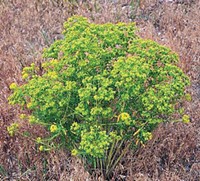Since finishing the Canyonlands half-marathon in March, I've been sadly neglecting my training regimen for June's endurance race. So, with the trails just drying out after a recent dash of rain, I thought it was time to get back in the saddle—and, while I was at it, check on the state of the foothills this spring.
Specifically, I wanted to know where the weeds were spreading. Invasive plants—anything non-native with high potential for displacing local vegetation—have made a nice home for themselves in Utah's mountains and canyons. There are currently 441 invasive forbs, grasses, trees, aquatics, shrubs and vines found in Utah, but it's the 27 listed noxious weeds, according to the Utah Noxious Weed Act, that are "especially injurious to public health, crops, livestock, land or other property."
After I stepped out the door of my truck at the Bonneville Shoreline Trailhead near Hogle Zoo, I took only four steps before my feet hit non-native vegetation. The entire field was covered with weeds—not the kind you pull from your garden: dandelions and volunteer sunflowers and such. These were the kind that are found on the botanical equivalent of a wanted poster, the outlaws of the weed world, noxious invaders from other continents: dyer's woad, perennial pepperweed, Canada thistle and Johnsongrass.
But the weed I'd come to find was conspicuously absent. I was on the lookout for spurge.
A growing scourge in Salt Lake City's foothills, across the state and even throughout the West, leafy and myrtle spurge started out as a benign Eurasian plant before finding its way into American flowerbeds. Often planted by the most well-intentioned gardeners, this highly drought-tolerant plant is widely used in water-wise and xeriscape landscaping. But over the decades, its hardiness and ability to spread has made it one of Utah's most reviled noxious weeds. It is now illegal for nurseries in Salt Lake County to sell spurge, and many other nurseries are voluntarily pulling it from their shelves. Still, the plant continues to spread far outside of the city limits.
My first spurge sighting of the day came when I crested the first big hill. There, in the dry gray shale slope, were the tell-tale shin-high stalks, their rosettes of sage-green leaves unmistakable even without the mature caps of little yellow cupped flowers.
Each year, the Unites States faces annual economic losses, totaling around $20 billion, due to weed-caused crop damage, soil erosion, watershed damage and impacted wildlands totaling around $20 billion. Spurge is particularly dangerous to livestock and humans because of its toxic milky-white sap, which can kill cattle and cause serious skin irritation and even blindness in people. The Utah Weed Control Association calls the state's growing noxious weed problem "a raging biological wildfire—out of control, spreading rapidly," but there are efforts underway to educate the public—efforts that one day will hopefully turn the tide on this biological threat.
For the past nine years, Salt Lake County Weed Control, along with other local groups, have hosted a spring Purge Your Spurge event inviting community members to pull the noxious foes from their gardens and turn them in for disposal. In April, Purge Your Spurge volunteers met to dig weeds from the Grandeur Peak trail. The Weber Office of the Uinta-Wasatch-Cache National Forest also organized weed-pull days on May 7-9 in three Weber County locations.
If you missed those events, there are still opportunities to volunteer on weed-pulling crews. Red Butte Garden, along with Salt Lake County Weed Control, will host noxious weed-pull events in Red Butte Canyon May 19, May 28 and June 6 (contact Neal Dombrowski, 801-587-9951). The Cottonwood Canyon Foundation, a local nonprofit, runs a volunteer program,Weed Warriors, in Millcreek and Big and Little Cottonwood canyons all summer long (contact Cottonwood Canyons Foundation by calling 801-466-6411).
My training run took me to the top of a knoll looking up into Emigration Canyon where, as I caught my breath, I spied two more small clusters of spurge spearing up from the ground. I felt defeated—by the hill and the spurge—until two days later, when on a walk by my neighbor's garden, I noticed his spurge plants were gone. "A friend told me to pull it," he said. "It's nasty stuff."
More by Katherine Pioli
-
Support Systems
Brine Dance and RDT work together to give showcase opportunities to dancers and choreographers.
- Sep 18, 2019
-
Feminine Mystique
Girl Child explores the trialsand treasures of being a woman.
- May 15, 2019
-
Oquirrh West Revival
A small company re-launches with the help of a big-name choreographer.
- Mar 20, 2019
- More »




